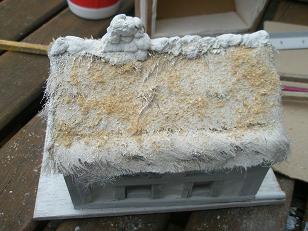After last week’s trip to the theatre, today I took some time back in the sunshine to work on the cottages, although some windy moments did see me chasing things around the garden.
I've started to paint up the cottage I was working on the other week. Here I’ve pretty much followed the original painting guide for old woodwork I learnt back when I first started, when I built the Coaching Inn following the instructions in the early White Dwarf Magazine.
First stage for the woodwork is to paint it with a black undercoat to give it depth and to help with the aged look.
Then I painted over the black undercoat with Burnt Umber.
After I mixed a fifty / fiftyish mix of Burnt Umber and White paint. This time instead of brushing it on I dabbed it on with a semi dry brush so as not to completely smother the original coat of Burnt Umber.
The last stage (which I’ll pick up later in the week) is to dry brush with white to give the final aged look. I might also pick the door out with a slightly redder brown shade also just to differentiate the different wood used for the door to the rest of the building before I perform the dry brushing.
I also covered the base with sawdust to keep this model in the same style as my original country cottages with bases. To do this I basically covered the base with PVA glue and sprinkled the sawdust on between paint sessions.
Then once the glue was dry I painted over with black, I found it easier to practically squirt the paint from the tube directly onto the base then work the paint over rather than the traditional paint it on approach. This then secures the sawdust from falling off, I will later colour this up with some green paint and green flocking as well.



















